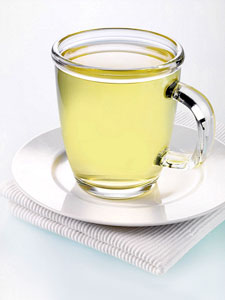Between the Leaves April 2008
No matter what I do, I can't make a good cup of tea. I've tried everything from Lipton bags to premium leaf, tap water to triple-Brita filtered, thirty seconds to seven minute infusions...and I fail. Almost all the tea I make develops an oily-looking scum or sickening 'floaties'. What am I doing wrong?

If it makes you feel any better, I'm well acquainted with scum, too. When I went away to college, every cup I made was floatie-infested; unless I paid food service good money to hand me a Styrofoam cup, a Bigelow bag, and a bottle of Ice Mountain. For months, I was half-convinced that Styrofoam had magical, scum-fighting properties. Thankfully, I roomed with a girl who was addicted to iced tea. She made a giant pitcher every day, and to my eternal fascination-never seemed to suffer from scum. One day I choked back my tea pride and asked her to show me the way.
The instant she threw lemon slices into her boiling water, I knew what caused the scum.
See, I went to school in the great state of Indiana, and Indiana is known for three things: corn, car racing,and its endless supply of limestone. Unfortunately for tea lovers, all this limestone dissolves into groundwater in the presence of carbon dioxide and creates 'hard' water. When hard water is heated, carbon dioxide starts to leave the water and the limestone, or calcium carbonate, begins to reform.
For most culinary applications, this isn't too much of a problem as it takes a good couple minutes of boiling for the calcium solids to become visible 'snow' at the bottom of the heating vessel. However, when tea is made from that just-heated water, some of the tea polyphenols at the liquid's surface react with oxygen in the air, and those excited molecules latch onto those very small calcium carbonate solids to create scum. It looks absolutely terrible, but it is safe to drink.
If you have the misfortune to live in a hard water zone, there is hope: scum can be prevented. Unfortunately, the least expensive methods will alter the flavor of your tea as they require changing the pH of your tap water. My roommate did this with her acidic lemon addition, and since she loved lemon in her iced tea, it worked wonderfully for her. You could also try making triple-strength tea, as the brew itself is mildly acidic in stronger concentrations. Unfortunately, any dilution would raise the pH and could cause scum to, depending on the temperature of the diluting water and the length of time the tea would be stored. Alternately, you could add milk-which is ever-so-slightly acidic-to your water before brewing the tea, but only the most British of Britons seem to like the resulting taste.
If none of these solutions are plausible to your palate, then you have two final options. The first is simply to use bottled water for all your brewing purposes. If however you'd rather work with your own tap water, then you will need some sort of home water treatment system. Unfortunately, the most least expensive type, activated charcoal, does not remove calcium or magnesium, leaving only water softeners and reverse osmosis systems as viable tools. Both do have notable disadvantages, mainly the 40 pound bags of salt for the softeners and the multiple filters for RO. In addition, RO filtration is extremely effective at mineral removal and can make tea water taste flat. Some counter this by adding a little table salt or a commercial mineral replacement extract back to their RO tea water. If either of these systems interests you, please research them before purchasing. They're fantastic devices, but they are not right for every living situation.
